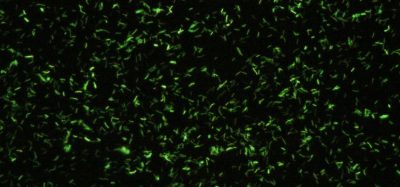iSIM-TIRF microscope offers unprecedented look at biological processes in living cells
Posted: 10 May 2018 | European Pharmaceutical Review | No comments yet
NIH researchers combine two microscope technologies to create sharper, faster images…


Scientists have combined two different microscope technologies to create sharper images of rapidly moving processes inside a cell.
In a paper, Dr Hari Shroff, chief of National Institute of Biomedical Imaging and Bioengineering (NIBIB) lab section on High-Resolution Optical Imaging (HROI), describes his new improvements to traditional Total Internal Reflection Fluorescence (TIRF) microscopy. TIRF microscopy illuminates the sample at a sharp angle so that the light reflects back, illuminating only a thin section of the sample that is extremely close to the coverslip. This process creates very high contrast images because it eliminates much of the background, out-of-focus, light that conventional microscopes pick up.


The rapid movements of Rab11 particles can be clearly imaged with the new instant TIRF-SIM microscope. (Dr Hari Shroff, NIBIB)
While TIRF microscopy has been used in cell biology for decades, it produces blurry images of small features within cells. In the past, super-resolution microscopy techniques applied to TIRF microscopes have been able to improve the resolution, but such attempts have always compromised speed, making it impossible to clearly image objects that move rapidly. As a result, many cellular processes remain too small or fast to observe.
Dr Shroff and his team realised that if they could take a high-speed, super-resolution microscope and modify it to act like a TIRF microscope, they could obtain the benefits of both. Instant structured illumination microscopy (iSIM), developed by the Shroff lab in 2013, can capture video at 100 frames per second, which is more than 3 times faster than most movies or internet videos. However, iSIM does not have the contrast that TIRF microscopes do. The team designed a simple “mask” that blocked most of the illumination from the iSIM—mimicking a TIRF microscope. Combining the strengths of both types of microscopy enabled the researchers to observe rapidly moving objects about 10 times faster than other microscopes at similar resolution.
“TIRF microscopy has been around for more than 30 years and it is so useful that it will likely be around for at least the next 30,” said Dr Shroff. “Our method improves the spatial resolution of TIRF microscopy without compromising speed — something that no other microscope can do. We hope it helps us clarify high-speed biology that might otherwise be hidden or blurred by other microscopes so that we can better understand how biological processes work.”
For example, with the new microscope, Dr Shroff and his team were able to follow rapidly moving Rab11 particles near the plasma membrane of human cells. Attached to molecular cargo that are transported around the cell, these particles move so fast that they are blurred when imaged by other microscopes. They also used their technique to reveal the dynamics and spatial distribution of HRas, a protein that has been implicated in facilitating the growth of cancerous tumours. As with all of the microscopes developed by the Shroff team, researchers are welcome to contact the lab to try the microscope out, or to acquire free schematics of the technology.
The paper has been published in Nature Methods.
Related topics
Related organisations
National Institute of Biomedical Imaging and Bioengineering (NIBIB)









